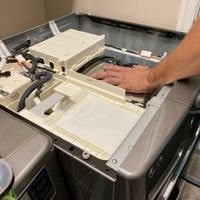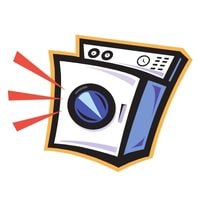Whirlpool Dryer Makes Noise. One of the most unnerving sounds to hear in your home when an appliance isn’t behaving properly.
When you hear the unexpected noise from your Whirlpool dryer, the first instinct is to see if you can find the problem in a definitive way with our expert guidance.
From squealing to clicking and clunking to a screeching, we’ll decode your Whirlpool dryer issue and offer expert advice on how to handle getting it repaired or maintaining it yourself!
Whirlpool Dryer Makes Noise
If your Whirlpool dryer making noise sounds like screeching or squealing it could be caused by a blower wheel complication.
Loud noises can also result if a loose blower wheel sleeve makes the wheel wobbly. This can occur if small, loosely held items clog the blower wheel.
This article discusses some problems with whirlpool dryers when they make noise.
Worn-Out Drum Roller
A broken drum roller can result in a worn-out washing machine bearing, which will make the entire machine and its components run loud. Dryers have at least two rear drum rollers that help the entire drum rotate.
These support rollers will either wear out or become damaged over time if one or more is damaged it won’t rotate as smoothly and you’ll likely hear a loud thumping every time it spins.
You can diagnose whether or not your dryer’s rollers are faulty by inspecting them for dents, scrapes, cracks, or any other visible signs of damage.
You should always replace all three front and back roller sets when they become worn to avoid breaking one and making your washer door fit poorly again.
Maintenance Kit problem
If your dryer is making unusual noise and you’re not sure which part exactly needs to be replaced, you can upgrade it with a dryer maintenance kit.
The dryer maintenance kit contains a list of parts commonly defective when the dryer is making noise, and they are all readily available at home depot. Search for your model number to find the parts applicable to your machine.
Drum Bearing Failure
The drum bearing holds the dryer drum at the rear. Over time, the dryer drum becomes worn and unable to function properly. If a dryer is making loud squeals or grinding sounds, it is likely that its drum bearing needs replacing.
To check if this is the case remove the dryer belt (which many homeowners have replaced but do not know how) and turn the drum by hand while listening carefully for signs of distressed bearings.
If it makes noises when being turned and/or seems very hard to operate, then chances are you will need to replace your old damaged bearings before any further damage is done to your appliance’s internal components.
Defective Blower Wheel
The blower wheel circulates the air from outside into your house, and it’s what makes a clothes dryer work. In case you didn’t know, there are little holes on the side of the blower that can get filled up with lint or socks and small articles of clothing.
If something gets stuck in there, then the entire thing can be thrown off, which results in loud noises on top of the uneven circulation, which will affect drying times.
The best way to correct this is to clean off any unfortunate items that might have ended up snagged in there. However, if this doesn’t do the trick, you need to entirely replace the blower wheel.
When it spins too quickly, like the blades weren’t aiming at a steady surface, that can cause it to wobble or even possibly snap while spinning so it would no longer be sturdy enough to stand on its own.
Whirlpool Dryer Noise
Below are some noises in a whirlpool.
Noise Of Pounding
A dryer without legs may vibrate or sound like it is rattling on a floor that isn’t level, which will cause some pounding noise. The legs of a Dryer are adjustable so that the dryer sits on an unevenly leveled surface.
Check if any of the four legs under your drier are missing. Replace or install the missing leg and adjust the height so that all four legs sit level with the ground.
You can do this by using a board to prop up one end at a time while checking if it sits level in both directions. If your dryer is not level, moisture sensing may be affected.
Noise Of Scraping
Scraping sounds often occur after turning on the dryer, only to find your clothes aren’t drying the way they should. To stop this racket, inspect the drum for loose lint or small items caught in the seams of your dryer at the front or back.
In most cases, coins and other foreign objects can fall out of pockets by accident and become lodged into these seams. Turn off your dryer immediately if you notice any unusual noises while it’s running so as not to irritate any friends who happen to be over at that moment.
Be sure to check pockets before washing clothes or taking them out of the dryer when they’re done drying. Being proactive is a great way to prevent clothing creases from forming and keep coins from dropping out of one’s wallet while on laundry duties.
Sound Of Clicking
Sometimes when you’re drying clothes, and you can’t hear the dryer making a lot of clicking noise, it’s because it doesn’t necessarily mean that something is wrong with your sound.
As the gas valve starts opening and closing, releasing gas as well as air in short bursts relative to the drum turning, this causes the extended low-pitched humming noise to be more noticeable on higher settings.
Sounds Of Thumping
Thumping and pumping sounds may occur in your washer or dryer. The washing machine platform or the tee assembly may be loose, causing noise. If this is suspected, remove the platform and tighten all four bolts.
Properly secure behind the machine. Check for missing, cracked, or broken rollers on the tee assembly using a flashlight with a mirror being sure not to allow light inside the motor to prevent possible electrocution. Replace as needed.
Thumping noises in your dryer may also be due to loud dryer duct connections between your dryer and wall fitting that are rubbing against the wall outlet box, causing vibration.
Tighten the connections using appropriate tools and secure screws into wood studs behind the wall with proper anchors where necessary.
Related Guides
